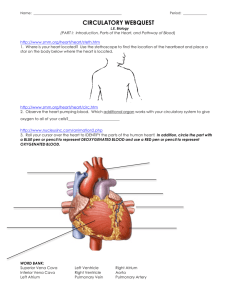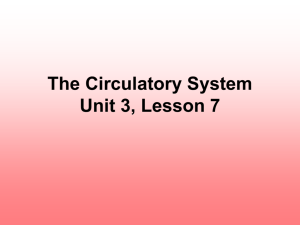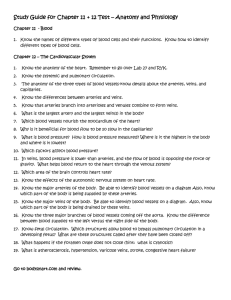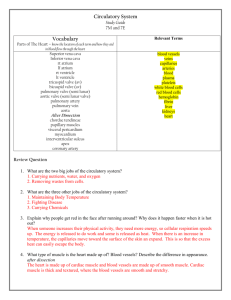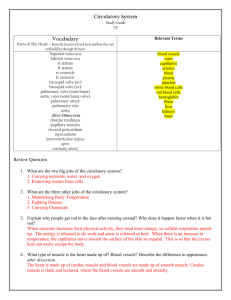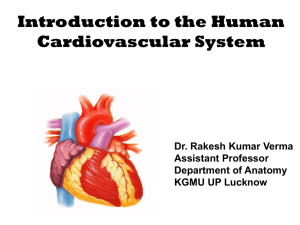Name: Period: CIRCULATORY WEBQUEST Prep Biology (PART I
advertisement
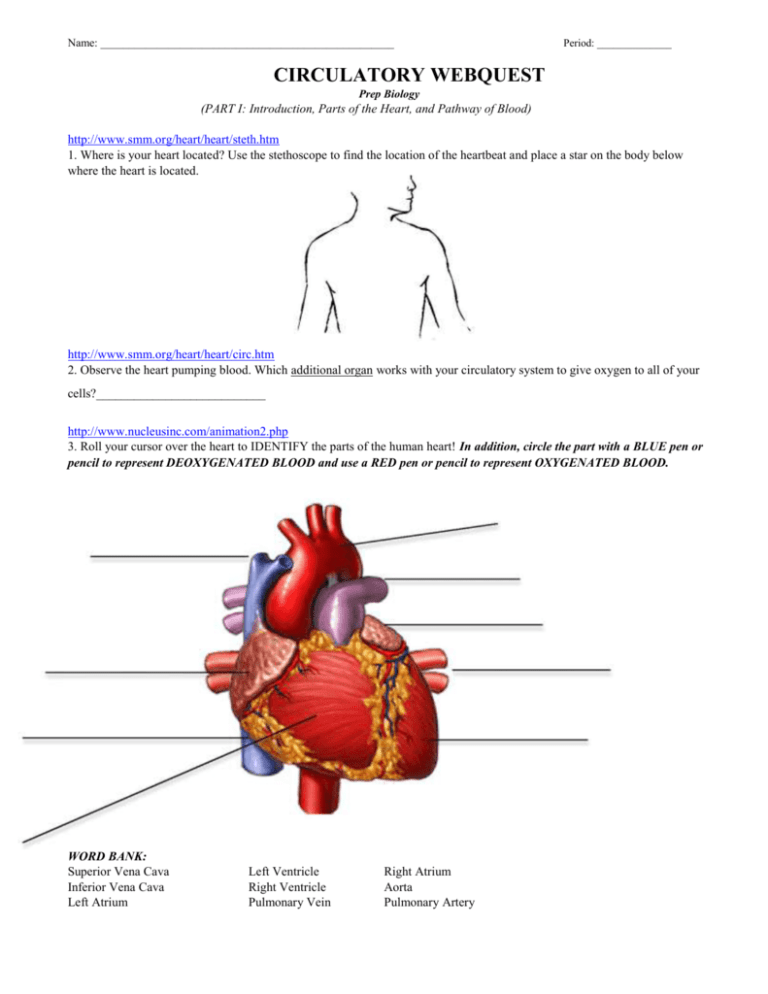
Name: ____________________________________________________ Period: ______________ CIRCULATORY WEBQUEST Prep Biology (PART I: Introduction, Parts of the Heart, and Pathway of Blood) http://www.smm.org/heart/heart/steth.htm 1. Where is your heart located? Use the stethoscope to find the location of the heartbeat and place a star on the body below where the heart is located. http://www.smm.org/heart/heart/circ.htm 2. Observe the heart pumping blood. Which additional organ works with your circulatory system to give oxygen to all of your cells?___________________________ http://www.nucleusinc.com/animation2.php 3. Roll your cursor over the heart to IDENTIFY the parts of the human heart! In addition, circle the part with a BLUE pen or pencil to represent DEOXYGENATED BLOOD and use a RED pen or pencil to represent OXYGENATED BLOOD. WORD BANK: Superior Vena Cava Inferior Vena Cava Left Atrium Left Ventricle Right Ventricle Pulmonary Vein Right Atrium Aorta Pulmonary Artery 4. Flash Cards on Parts of the Heart http://quizlet.com/1969655/parts-of-the-heart-andtheir-functions-flash-cards/ Step One: View the flash cards several times. Step Two: Press on the box that is titled "LEARN." Try to type in the correct term that matches each description. Step Three: Press on the box that is titled "TEST." When you are done with the test, record the number of questions you had that where correct and the number that where incorrect. In addition, have your teacher sign the box that says "Completed Practice Test." Number of Questions Correct ____________/14 ______________________________________ Number of Questions Incorrect __________/14 Completed Practice Test (Teacher's Signature) NOTE: You do not need to know all of the terms in this activity. See the list below: Terms you ARE responsible for: Aorta Pulmonary Vein Pulmonary Artery Left Ventricle Oxygenated Right Ventricle Deoxygenated Arteries Right Atrium Veins Vena Cava Terms you are NOT responsible for: Coronary Vessels Bicuspid Valve Tricuspid Valve http://www.purposegames.com/game/label-the-hearts-parts-quiz 5. Practice will make perfect! Play the game to identify the parts of the heart below. NOTE: You must click on "START" first! Call over Ms. Fullhart or Ms. Caliendo and a prize willl be awarded to the student who can do it the fastest with 100% accuracy! How long did the game take you? (Does not matter how long as long as you can identify all of the parts!) ____________________________________________ http://kidshealth.org/parent/general/body_basics/heart.html About the Heart and Circulatory System 6. What are the three main parts of the circulatory system? A. _________________________B. __________________________C. _________________________ 7. In class, during brain pop, we learned about three types of circulation. This website does not discuss coronary circulation, the type of circulation movement of blood in and around the heart. Define the other types of circulation discussed on the site. Pulmonary Circulation: _______________________________________________________________________________ Systemic Circulation: _________________________________________________________________________________ Click on "Body Basics: Heart" View the animation of blood flow through the heart and fill in the blanks below. When blood circulates in the body, it enters the heart through the _______________________________, [asses through to the _______________________________, and flows out through the __________________________ to the _________________________-where it picks up _____________________ and gets rid of __________________________________. From the lungs, blood returns to the ______________________________ and enters the _____________________________ where it is pumped to the body through the _______________. http://www.youtube.com/watch?v=mH0QTWzUxI&safety_mode=true&persist_safety_mode=1&safe=active http://www.youtube.com/watch?v=FCimR_P9ID0&feature=related&safety_mode=true&persist_safety_mo de=1&safe=active http://www.heartpoint.com/theheart.html Watch the videos above on the pathway of blood. Write out the flow of blood from the time it enters the heart to the time it leaves the heart. In addition, outline each box with a red or blue pen/colored pencil to show low levels of oxygen (BLUE) and high levels of oxygen (RED). Valve From Above the Heart Valve OR From Below the Heart Valve Pulmonary Artery Valve The entire body http://www.sciencelearn.org.nz/Contexts/See-through-Body/Sci-Media/Animations-andInteractives/Label-the-heart PART II: Blood Pressure & Blood Vessels http://www.lifeclinic.com/focus/blood/whatisit.asp What is Blood Pressure? 1. Blood is carried from the heart to all parts of your body in vessels called ______________________________. 2. Blood pressure is the force of the blood _____________________________________________________________ _____________________________________________________________________________________________________. 3. Your blood pressure is at its ______________________________ when the heart __________________________, pumping the blood. This is called _____________________________________________________________________. 4. When the heart is at ______________________, between __________________________, your blood pressure ________________________. This is the ___________________________________________________________________. _______5. How is blood pressure written? A. With one number, the systolic pressure B. With one number, the diastolic pressure C. With two numbers, the diastolic pressure over the systolic pressure D. With two numbers, the systolic over the diastolic pressure 6. What blood pressure is considered normal? _______________ Any blood pressure above ________________ is considered too ________________. 7. Scroll down to "Do you have white coat hypertention?" What is this condition? Explain. _______________ ______________________________________________________________________________________________________ http://www.webmd.com/hypertension-high-blood-pressure/guide/blood-pressure-causes What causes high blood pressure? List four causes and identify if any of these causes are preventable or controllable. Cause Preventable (Yes or No) http://www.neok12.com/php/watch.php?v=zX7152787e557e671b564073&t=Circulatory-System Watch the video on the types of blood vessels. If the video is not working, you will have to refer to your notes or research each answer. 1. Arteries contain blood that is a. high in oxygen. b. low in oxygen. c. both high and low in oxygen. 2. Arteries carry blood a. away from the heart. b. to the heart. c. both away and to the heart. 3. The smallest blood vessel is the a. vein b. artery c. capillary 4. Which blood vessel is the site of diffusion, where oxygen is dropped off and carbon dioxide is picked up? a. artery b. capillary c. vein 5. Veins contain blood that is a. high in oxygen. b. low in oxygen. c. both high and low in oxygen. 6. Veins carry blood a. away from the heart. b. to the heart. c. both away and to the heart. http://www.e-learningforkids.org/Courses/Liquid_Animation/Body_Parts/Heart_and_Circulation/index.html Click "Let's Go!" Click on "Blood Pressure" 1. Why can having low blood pressure be just as dangerous as having high blood pressure? _____________ _______________________________________________________________________________________________________ Click "Replay" Click "Arteries" 2. Why is the blood in your arteries bright red? _________________________________________________________ 3. As arteries get farther and farther away from the heart they get smaller and smaller and branch into tiny blood vessels called _______________________________________. Click "Replay" Click "Capillaries" 4. What is the function of capillaries in your body? ______________________________________________________ 5. Label the diagram below: ! ! ! ! ! ! ! ! ! ! ! ! ! ! ! ! 6. Why does the capillary change color as it passes buy your body cells? ________________________________ _______________________________________________________________________________________________________ Click "Replay" Click "Veins" 7. Veins collect blood from ____________________________ and bring it back to the heart. 8. Why is the blood in veins dark red (blue)? ___________________________________________________________ 9. Inside your veins there is ___________________________ pressure. a. high ! Now, it is time to see how much you have learned! Take the quiz below on the blood vessels found in your body! ! ! ! ! ! ! ! ! ! ! ! ! ! ! ! ! ! ! ! ! ! ! ! ! ! ! ! ! ! ! ! ! ! ! b. low Good Luck! Part III: Blood http://www.e-learningforkids.org/Courses/Liquid_Animation/Body_Parts/Blood/index.html ! 1. Be a scientist and take a closer look at the components of blood! Click on each cell to findout more about it and answer the questions below. Note: You will have to click "Replay" to view the function of each part of blood. Component (Part) of Blood Red Blood Cells Job What do they look like? ! ! ! White Blood Cells ! (Monocytes/Macrophages) ! Platelets ! ! ! ! ! See the facts below the blood vessel to answer the questions below. 1. Where are blood cells made? _____________________________________________________________________ 2. True or False: White blood cells can leave the blood vessels and travel into your tissues. Why would this be an advantage? ___________________________________________________________________________________ ______________________________________________________________________________________________________ 3. What are the four blood types? A. B. C. D. 4. Which blood type is most common? _______________________ 5. What is "blood count?" _____________________________________________________________________________ Click on "Yucky Bites" 6. What is in pus? ____________________________________________________________________________________ 7. Why does blood taste salty? ______________________________________________________________________ http://www.wisc-online.com/objects/index_tj.asp?objID=AP14604 RED BLOOD CELLS 1. Blood is called the “River of ____________________”because it carries: 2. _____________is the FLUID COMPONENT of blood and makes up___________%. 3. ____________makes up the remaining percentage of blood. 4. Red Blood Cells are also known as _______________________________. What is their main function? _______ _______________________________________________________________________________________________________ 5. How are Red Blood Cells designed to perform this function? __________________________________________ ______________________________________________________________________________________________________ 6. What is HYPOXIA or CYONOTIC mean? _____________________________________________________________ 7. How long do Red Blood Cells live for?_______________ http://www.wisc-online.com/objects/index_tj.asp?objID=AP14704 WHITE BLOOD CELLS 1. White blood cells are also known as _________________________________. 2. Almost all blood cells are formed from ________________________________, a type of stem cell found in the _________________________. 3. White blood cells called MACROPHAGES, perfom PHAGOCYTOSIS…what is this process? _______________ _______________________________________________________________________________________________________ Draw a picture to support your answer: http://www.medindia.net/know_ur_body/cirsystem.asp DID YOU KNOW? 1. Every second, __________________________ are destroyed in the human body. 2. Human blood is _____________________________. It is the ________________________; a pigment present in the __________________________that is responsible for the ______________color of the blood. 3. ________________________ is nothing but the sound produced by the closure of ____________________of the heart when the blood is pushed through its chamber. 4. A _________________________'s heart beat is faster than that of a ________________________'s. 5. The human heart continues to __________________ even after it is taken out of the body or cut in to pieces. http://www.sciencekids.co.nz/sciencefacts/humanbody/blood.html Facts About Blood 1. Blood makes up around _________________ of the weight of a human body. 2. Blood contains ________________________, _______________________ and ________________________. 3. These blood cells float in a yellow liquid called blood _______________________. Blood ________________ is made up of ______________ water and also contains various nutrients, electrolytes, gases, proteins, glucose and hormones.
